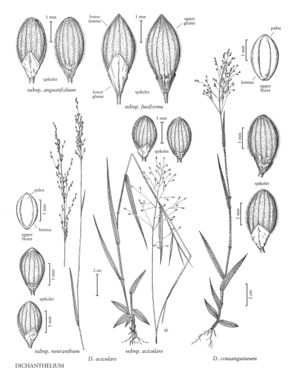Dichanthelium consanguineum
Plants grayish-green, cespitose. Basal rosettes poorly differentiated; blades 2-8 cm, ovate to lanceolate, grading into the cauline blades. Culms 20-55 cm, erect; nodes densely bearded; internodes densely villous; fall phase with spreading culms branching from the lower and midculm nodes, eventually producing flabellate clusters of reduced, flat blades, secondary panicles much reduced. Cauline leaves 3-4; sheaths shorter than the internodes, pilose with ascending papillose-based hairs to villous; ligules 0.5-2 mm, of hairs; blades 4-12 cm long, 2-8 mm wide, stiffly ascending to erect, often wrinkled along the prominent veins, usually villous on both surfaces, apices involute-pointed, blades of the flag leaves much reduced. Primary panicles 3-7 cm long, 1-4 cm wide, well-exserted; branches usually ascending, glabrous or puberulent. Spikelets 2.3-3 mm long, 1.4-1.8 mm wide, obovoid, biconvex in side view, densely pubescent, attenuate basally. Lower glumes about 1/3 as long as the spikelets, attached about 0.2 mm below the upper glumes, clasping at the base, broadly triangular, thinner than the upper glumes, weakly veined; upper glumes with 5-9 prominent veins; lower florets sterile; upper florets broadly ellipsoid, apices blunt, minutely puberulent. 2n = 18.
Distribution
Va., Miss., Tex., La., Ala., Tenn., N.C., S.C., Ark., Ga., Ind., Iowa, Fla.
Discussion
Dichanthelium consanguineum grows in sandy woodlands and low, boggy pinelands. It is restricted to the southeastern United States. The primary panicles are open-pollinated and produced from April to June; the secondary panicles are cleistogamous and produced from June into fall. Some specimens of D. consanguineum suggest that hybridization occasionally occurs with D. aciculare or D. ovale.
Selected References
None.
Lower Taxa
"usually distinctly longer and narrower" is not a number."decumbent" is not a number.
